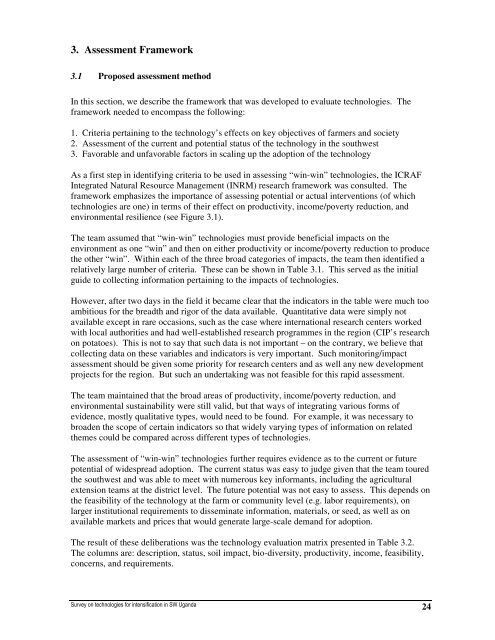Technologies for intensification in SW Uganda ... - Foodnet - cgiar
Technologies for intensification in SW Uganda ... - Foodnet - cgiar
Technologies for intensification in SW Uganda ... - Foodnet - cgiar
Create successful ePaper yourself
Turn your PDF publications into a flip-book with our unique Google optimized e-Paper software.
3. Assessment Framework<br />
3.1 Proposed assessment method<br />
In this section, we describe the framework that was developed to evaluate technologies. The<br />
framework needed to encompass the follow<strong>in</strong>g:<br />
1. Criteria perta<strong>in</strong><strong>in</strong>g to the technology’s effects on key objectives of farmers and society<br />
2. Assessment of the current and potential status of the technology <strong>in</strong> the southwest<br />
3. Favorable and unfavorable factors <strong>in</strong> scal<strong>in</strong>g up the adoption of the technology<br />
As a first step <strong>in</strong> identify<strong>in</strong>g criteria to be used <strong>in</strong> assess<strong>in</strong>g “w<strong>in</strong>-w<strong>in</strong>” technologies, the ICRAF<br />
Integrated Natural Resource Management (INRM) research framework was consulted. The<br />
framework emphasizes the importance of assess<strong>in</strong>g potential or actual <strong>in</strong>terventions (of which<br />
technologies are one) <strong>in</strong> terms of their effect on productivity, <strong>in</strong>come/poverty reduction, and<br />
environmental resilience (see Figure 3.1).<br />
The team assumed that “w<strong>in</strong>-w<strong>in</strong>” technologies must provide beneficial impacts on the<br />
environment as one “w<strong>in</strong>” and then on either productivity or <strong>in</strong>come/poverty reduction to produce<br />
the other “w<strong>in</strong>”. With<strong>in</strong> each of the three broad categories of impacts, the team then identified a<br />
relatively large number of criteria. These can be shown <strong>in</strong> Table 3.1. This served as the <strong>in</strong>itial<br />
guide to collect<strong>in</strong>g <strong>in</strong><strong>for</strong>mation perta<strong>in</strong><strong>in</strong>g to the impacts of technologies.<br />
However, after two days <strong>in</strong> the field it became clear that the <strong>in</strong>dicators <strong>in</strong> the table were much too<br />
ambitious <strong>for</strong> the breadth and rigor of the data available. Quantitative data were simply not<br />
available except <strong>in</strong> rare occasions, such as the case where <strong>in</strong>ternational research centers worked<br />
with local authorities and had well-established research programmes <strong>in</strong> the region (CIP’s research<br />
on potatoes). This is not to say that such data is not important – on the contrary, we believe that<br />
collect<strong>in</strong>g data on these variables and <strong>in</strong>dicators is very important. Such monitor<strong>in</strong>g/impact<br />
assessment should be given some priority <strong>for</strong> research centers and as well any new development<br />
projects <strong>for</strong> the region. But such an undertak<strong>in</strong>g was not feasible <strong>for</strong> this rapid assessment.<br />
The team ma<strong>in</strong>ta<strong>in</strong>ed that the broad areas of productivity, <strong>in</strong>come/poverty reduction, and<br />
environmental susta<strong>in</strong>ability were still valid, but that ways of <strong>in</strong>tegrat<strong>in</strong>g various <strong>for</strong>ms of<br />
evidence, mostly qualitative types, would need to be found. For example, it was necessary to<br />
broaden the scope of certa<strong>in</strong> <strong>in</strong>dicators so that widely vary<strong>in</strong>g types of <strong>in</strong><strong>for</strong>mation on related<br />
themes could be compared across different types of technologies.<br />
The assessment of “w<strong>in</strong>-w<strong>in</strong>” technologies further requires evidence as to the current or future<br />
potential of widespread adoption. The current status was easy to judge given that the team toured<br />
the southwest and was able to meet with numerous key <strong>in</strong><strong>for</strong>mants, <strong>in</strong>clud<strong>in</strong>g the agricultural<br />
extension teams at the district level. The future potential was not easy to assess. This depends on<br />
the feasibility of the technology at the farm or community level (e.g. labor requirements), on<br />
larger <strong>in</strong>stitutional requirements to dissem<strong>in</strong>ate <strong>in</strong><strong>for</strong>mation, materials, or seed, as well as on<br />
available markets and prices that would generate large-scale demand <strong>for</strong> adoption.<br />
The result of these deliberations was the technology evaluation matrix presented <strong>in</strong> Table 3.2.<br />
The columns are: description, status, soil impact, bio-diversity, productivity, <strong>in</strong>come, feasibility,<br />
concerns, and requirements.<br />
24
















